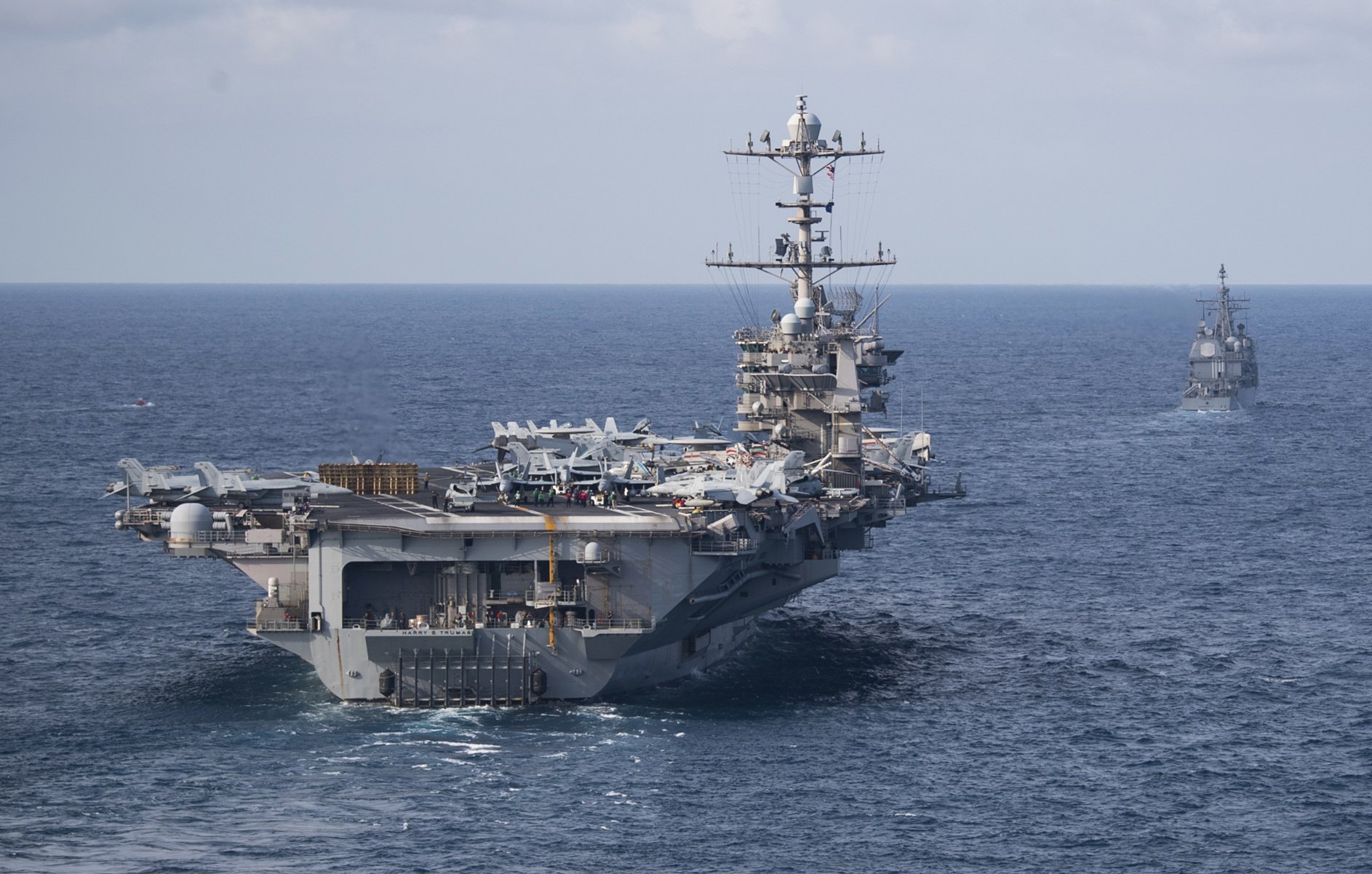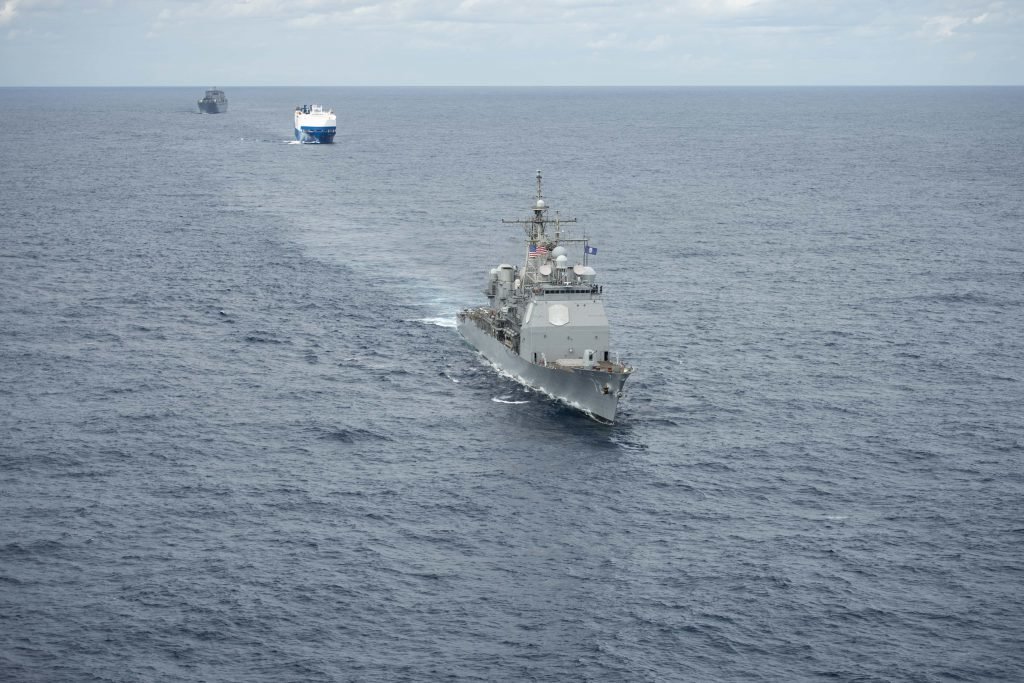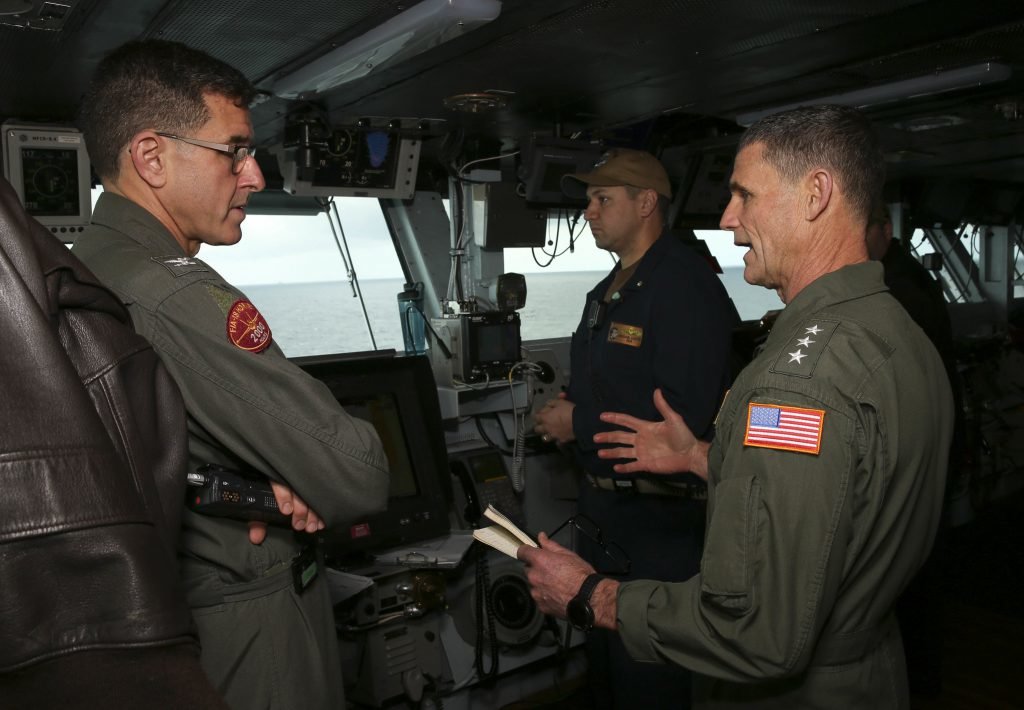NATO’s New Atlantic Command Rekindles Cold War Operations To Defend Europe from Russia

ATLANTIC OCEAN (July 18, 2019) The Nimitz-class aircraft carrier USS Harry S. Truman (CVN 75), front, and the Ticonderoga-class guided-missile cruiser USS Normandy (CG 60) transit the Atlantic Ocean. Harry S. Truman is underway conducting composite training unit exercise with the Harry S. Truman Carrier Strike Group. U.S. Navy photo by Mass Communication Specialist 2nd Class Scott Swofford/Released.
In the 1990 movie The Hunt for Red October, Capt. Marko Ramius, a Soviet submarine commander, speaks to his crew at the start of a cruise across the northern Atlantic Ocean. Ramius, who is played by Sean Connery, says: “Once more, we play our dangerous game, a game of chess against our old adversary — the American Navy. For 40 years, your fathers before you and your older brothers played this game, and played it well.”
That Cold War “dangerous game” between US and Russian naval forces in the Atlantic took a quarter-century hiatus following the Soviet Union’s collapse in 1991. After the Cold War, defending the Atlantic became a back burner priority for the US Navy. There simply wasn’t a clear and pressing threat to merit the ongoing investment of military resources in that effort, especially with counterinsurgency campaigns in Afghanistan and Iraq to support.
Yet, the times have changed. And the game is back on.
On Thursday, NATO’s newest command, Joint Force Command Norfolk, will become fully operational. Based in Norfolk, Virginia, the new command has an overarching mission to defend NATO’s northern Atlantic sea lanes from Russia’s navy.
The principal force composing NATO’s new Joint Force Command Norfolk is the US Navy’s 2nd Fleet, which was reestablished in 2018 to defend America’s East Coast and the northern Atlantic Ocean. The 2nd Fleet’s commander, Vice Adm. Andrew Lewis, concurrently commands NATO’s Joint Force Command Norfolk.
Russian submarine activity in the Atlantic is now at its highest levels since the Cold War, US and NATO officials say, posing a threat to military sealift ships that would supply US and NATO forces in Europe should a war break out with Russia.
“Within an increasingly complex global security environment, our allies and competitors alike are well aware that many of the world’s most active shipping lanes lie within the North Atlantic,” Lewis said in January. “Combined with the opening of waterways in the Arctic, this competitive space will only grow.”
The US and its Western allies are now fully immersed in a new era of so-called great power competition with Russia and China. And when it comes to the defense of Europe against Russia, defending the northern Atlantic Ocean is once again a priority for the Western alliance.
According to the Navy, if war were to break out in Europe, “the Department of Defense’s sealift transportation fleet expects to move approximately 90 percent of required assets from the US to the theater of conflict.”

“In a real world conflict, much of the military equipment must still go by sealift, which makes convoy operations a critical skill set to maintain and practice,” Capt. Hans Lynch, commodore of Military Sealift Command Atlantic, said in a February release.
Originally named the 2nd Task Fleet, the Navy’s 2nd Fleet was originally created during World War II and played a key role in defending the Atlantic from Soviet forces in the Cold War. Under orders from President John F. Kennedy, the 2nd Fleet carried out the naval quarantine around Cuba during the 1962 Cuban missile crisis.
The 2nd Fleet was disestablished in 2011 due to budgetary reasons. In response to the growing threat from Russia, it re-achieved full operational capacity in December 2019. In late February, the 2nd Fleet partnered with Military Sealift Command to conduct a convoy exercise across the northern Atlantic Ocean.
“The safest and quickest way to get needed materials to the front lines is via maritime convoy,” 2nd Fleet officials said in a February release regarding the convoy exercise, adding: “With the return to peer competition and access to sea lanes no longer guaranteed, it is important that the Navy and [Military Sealift Command] train together in order to ensure the successful delivery and sustainment of combat power necessary for the joint force to fight and win anywhere around the globe.”

In June 2018 NATO defense ministers decided to create two new commands to protect NATO’s logistical thoroughfares across the northern Atlantic Ocean.
Apart from Joint Force Command Norfolk, the other new command, the Joint Support and Enabling Command, is based in Ulm, Germany, and operates as a transit nexus for military hardware in and out of Europe. The Joint Support and Enabling Command was declared operational in September 2019.
In both World War I and World War II, US military sealift convoys took great risks to travel across the northern Atlantic, despite the persistent threat of German U-boats, to deliver troops and materiel to Europe and North Africa.
So, too, during the Cold War, the defense of the Atlantic’s sea lanes was essential to supplying NATO forces in Europe — although the US was able to pre-position a large amount of military hardware on the Continent during the Cold War. Nevertheless, the threat of Soviet ballistic missile submarines, which could effectively park off the Eastern Seaboard to launch nuclear-armed missiles at the US homeland, added even more urgency to NATO’s efforts to defend the northern Atlantic.
“The Atlantic is a battlespace that cannot be ignored,” said Lewis, commander of US 2nd Fleet, in February. “We need to be prepared to operate at the high end alongside our allies, partners and adversaries alike as soon as we’re underway.”

BRCC and Bad Moon Print Press team up for an exclusive, limited-edition T-shirt design!
BRCC partners with Team Room Design for an exclusive T-shirt release!
Thirty Seconds Out has partnered with BRCC for an exclusive shirt design invoking the God of Winter.
Lucas O'Hara of Grizzly Forge has teamed up with BRCC for a badass, exclusive Shirt Club T-shirt design featuring his most popular knife and tiomahawk.
Coffee or Die sits down with one of the graphic designers behind Black Rifle Coffee's signature look and vibe.
Biden will award the Medal of Honor to a Vietnam War Army helicopter pilot who risked his life to save a reconnaissance team from almost certain death.
Ever wonder how much Jack Mandaville would f*ck sh*t up if he went back in time? The American Revolution didn't even see him coming.
A nearly 200-year-old West Point time capsule that at first appeared to yield little more than dust contains hidden treasure, the US Military Academy said.












